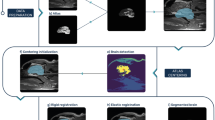Abstract
We developed two methods for the virtual extraction of the skull from the ultra short echo time MR images: i) an interactive and a semi-automatic scatterplot based segmentation as well as ii) a support vector machine (SVM) based segmentation. Both interactive and semiautomated procedures allow for good segmentation results. On the other hand it was possible to full automate the skull segmentation process with the SVM which delivered slightly better results. Four datasets were evaluated with the corresponding registered CT images using the Dice coefficients (D). The interactive scatterplot based method reached a mean D of 0.802 ± 0.070, the semi automatic one yielded a mean D of 0.791 ± 0.042 and the SVM based segmentation delivered a mean D of 0.828 ± 0.053.
Access this chapter
Tax calculation will be finalised at checkout
Purchases are for personal use only
Preview
Unable to display preview. Download preview PDF.
Similar content being viewed by others
References
Rota Kops E, Wagenknecht G, Scheins J, et al. Attenuation correction in MR-PET scanners with segmented T1-weighted MR images. IEEE Nucl Sci Symp Conf Rec. 2009; p. 2530 – 3.
Robson MD, Gatehouse PD, Bydder M, et al. Magnetic resonance: an introduction to ultrashort TE (UTE) imaging. J Comput Assist Tomogr. 2003;27(6):825–46.
Tyler DJ, Robson MD, Henkelman MR, et al. Magnetic resonance imaging with ultrashort TE (UTE) PULSE sequences: Technical considerations. J Magn Reson Imaging. 2007;25(2):279–89.
Dogdas B, Shattuck DW, Leahy RM. Segmentation of skull and scalp in 3-D human MRI using mathematical morphology. Hum Brain Mapp. 2005;26(4):273–85.
Begg R, Lai DTH, Palaniswami M. Computational Intelligence in Biomedical Engineering. CRC; 2007.
Abramoff MD, Magelhaes PJ, Ram SJ. Image Processing with ImageJ. Biophotonics International. 2004;11(7):36–42.
Ashburner J, Friston KJ. Rigid body registration. In: Frackowiak RSJ, et al, editors. Human Brain Function. 2nd ed. Academic Press; 2003.
Author information
Authors and Affiliations
Corresponding author
Editor information
Editors and Affiliations
Rights and permissions
Copyright information
© 2012 Springer-Verlag Berlin Heidelberg
About this chapter
Cite this chapter
Habes, M., Kops, E., Lipinski, HG., Herzog, H. (2012). Skull Extraction from MR Images Generated by Ultra Short TE Sequence. In: Tolxdorff, T., Deserno, T., Handels, H., Meinzer, HP. (eds) Bildverarbeitung für die Medizin 2012. Informatik aktuell. Springer, Berlin, Heidelberg. https://doi.org/10.1007/978-3-642-28502-8_47
Download citation
DOI: https://doi.org/10.1007/978-3-642-28502-8_47
Published:
Publisher Name: Springer, Berlin, Heidelberg
Print ISBN: 978-3-642-28501-1
Online ISBN: 978-3-642-28502-8
eBook Packages: Computer Science and Engineering (German Language)




